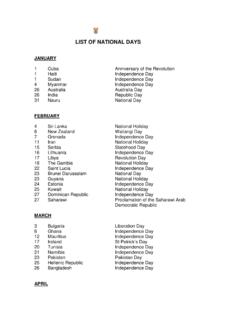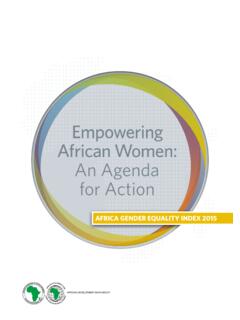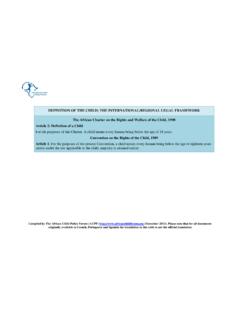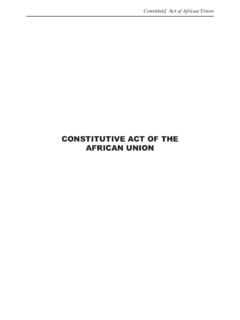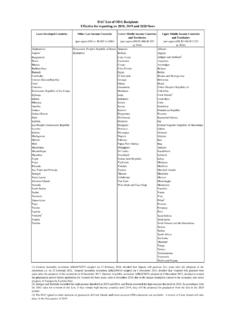Transcription of Statute - UNHCR
1 StatuteOF THE OFFICE OFTHE UNITED NATIONS HIGH COMMISSIONERFOR REFUGEESUNITED NATIONS HIGH COMMISSIONER FOR REFUGEES 2 3 GENERAL ASSEMBLY RESOLUTION 428 (V) OF 14 DECEMBER 1950 Statute OF THE OFFICEOF THE UNITED NATIONS HIGH COMMISSIONER FOR REFUGEES WITH ANINTRODUCTORY NOTEBY THE OFFICE OF THEUNITED NATIONS HIGH COMMISSIONER FOR REFUGEESUNHCR UNITED NATIONS HIGH COMMISSIONER FOR REFUGEES 4 INTRODUCTORY NOTEBY THE OFFICE OF THEUNITED NATIONS HIGH COMMISSIONER FOR REFUGEES( UNHCR )IN RESOLUTION 319 (IV) OF 3 DECEMBER 1949,the United Nations General Assembly decided to establish a HighCommissioner s Office for Refugees as of 1 January Statute of the Office of the United Nations High Commissionerfor Refugees was adopted by the General Assembly on 14 December1950 as Annex to Resolution 428 (V).
2 In this Resolution, reproducedon page 6, the Assembly also called upon the Governments tocooperate with the High Commissioner in the performance of his orher functions concerning refugees falling under the competence ofthe Office. In accordance with the Statute , the work of the HighCommissioner is humanitarian and social and of an entirely non-political functions of the High Commissioner are defined in the Statuteand in various Resolutions subsequently adopted by the GeneralAssembly. Resolutions concerning the High Commissioner s Officeadopted by the General Assembly and the Economic and SocialCouncil are available on RefWorld, UNHCR s High Commissioner reports annually to the General Assemblythrough the Economic and Social Council.
3 Pursuant to paragraph 4of the Statute , an Advisory Committee on Refugees was establishedby the Economic and Social Council (1) and was later reconstitutedas the United Nations Refugee Fund (UNREF) ExecutiveCommittee(2). The latter was replaced in 1958 by the ExecutiveCommittee of the High Commissioner s Programme (3) . Members of(1) Economic and Social Council Resolution 393 (XIII) B of 10 September 1951.(2) Economic and Social Council Resolution 565 (XIX) of 31 March 1955 adoptedpursuant to General Assembly Resolution 832 (IX) of 21 October 1954. 5 the Executive Committee are elected by the Economic and SocialCouncil on the widest possible geographical basis from those Stateswith a demonstrated interest in and devotion to the solution ofrefugee problems.
4 Under its terms of reference, the ExecutiveCommittee, inter alia, reviews and approves the material assistanceprogramme of the High Commissioner s office and advises the HighCommissioner at his or her request on the exercise of his or herfunctions under the Statute . The Executive Committee was originallycomposed of 24 states. By 1996, membership had expanded to 50states, comprising Algeria, Argentina, Australia, Austria, Bangladesh,Belgium, Brazil, Canada, China, Colombia, Denmark, Ethiopia,Finland, France, Germany, Greece, Holy See, Hungary, IslamicRepublic of Iran, Israel, Italy, Japan, Lebanon, Lesotho, Madagascar,Morocco, Namibia, Netherlands, Nicaragua, Nigeria, Norway,Pakistan, Philippines, Russian Federation, Somalia, Spain, Sudan,Sweden, Switzerland, United Republic of Tanzania, Thailand, Tunisia,Turkey, Uganda, United Kingdom, United States of America,Venezuela, Yugoslavia [Serbia and Montenegro]
5 , and first United Nations High Commissioner for Refugees was GerritJ. van Heuven Goedhart from the Netherlands (1951-1956). He wassucceeded by Auguste R. Lindt from Switzerland (1957-1960); FelixSchnyder from Switzerland (1961-1965); Sadruddin Aga Khan fromIran (1966-1977); Poul Hartling from Denmark (1978-1985); Jean-Pierre Hock from Switzerland (1986-1989); and ThorvaldStoltenberg from Norway (Jan. 1990-Nov. 1990). The present HighCommissioner is Sadako Ogata from Japan, who assumed office on18 February s headquarters are located in Geneva, Switzerland. TheHigh Commissioner has appointed representatives andcorrespondents in over 120 countries throughout the , March 1996(3) General Assembly Resolution 1166 (XII) of 26 November 1957 and Economic andSocial Council Resolution 672 (XXV) of 30 April 1958.
6 6 THE GENERAL ASSEMBLY,In view of its resolution 319 A (IV) of 3 December 1949, the annex to the present resolution, being the Statute ofthe Office of the United Nations High Commissioner for Refugees; upon Governments to co-operate with the United NationsHigh Commissioner for Refugees in the performance of his functionsconcerning refugees falling under the competence of his Office,especially by:(a)Becoming parties to international conventions providing for theprotection of refugees, and taking the necessary steps of imple-mentation under such conventions;(b)Entering into special agreements with the High Commissionerfor the execution of measures calculated to improve thesituation of refugees and to reduce the number requiring pro-tection;(c)Admitting refugees to their territories, not excluding those inthe most destitute categories;(d)Assisting the High Commissioner in his efforts to promote thevoluntary repatriation of refugees;(e)Promoting the assimilation of refugees, especially by facilitatingtheir naturalization.
7 GENERAL ASSEMBLY RESOLUTION 428 (V)of 14 December 1950 7 (f)Providing refugees with travel and other documents such aswould normally be provided to other aliens by their nationalauthorities, especially documents which would facilitate theirresettlement;(g)Permitting refugees to transfer their assets and especially thosenecessary for their resettlement;(h)Providing the High Commissioner with information concerningthe number and condition of refugees, and laws and regulationsconcerning the Secretary-General to transmit the present resolution,together with the annex attached thereto, also to States non-membersof the United Nations, with a view to obtaining their co-operationin its implementation.
8 8 CHAPTER IGeneral United Nations High Commissioner for Refugees, actingunder the authority of the General Assembly, shall assume thefunction of providing international protection, under the auspices ofthe United Nations, to refugees who fall within the scope of thepresent Statute and of seeking permanent solutions for the problemof refugees by assisting Governments and, subject to the approval ofthe Governments concerned, private organizations to facilitate thevoluntary repatriation of such refugees, or their assimilation withinnew national the exercise of his functions, more particularly when difficultiesarise, and for instance with regard to any controversy concerning theinternational status of these persons, the High Commissioner shallrequest the opinion of the advisory committee on refugees if it work of the High Commissioner shall be of an entirely non-political character.
9 It shall be humanitarian and social and shallrelate, as a rule, to groups and categories of High Commissioner shall follow policy directives given himby the General Assembly or the Economic and Social Economic and Social Council may decide, after hearing theANNEXSTATUTE OF THE OFFICEOF THE UNITED NATIONS HIGH COMMISSIONERFOR REFUGEES 9 views of the High Commissioner on the subject, to establish anadvisory committee on refugees, which shall consist ofrepresentatives of States Members and States non-members of theUnited Nations, to be selected by the Council on the basis of theirdemonstrated interest in and devotion to the solution of the General Assembly shall review, not later than at its eighthregular session, the arrangements for the Office of the HighCommissioner with a view to determining whether the Office shouldbe continued beyond 31 December IIFunctions of the High competence of the High Commissioner shall extend to:A.
10 (i)Any person who has been considered a refugee under theArrangements of 12 May 1926 and of 30 June 1928 or underthe Conventions of 28 October 1933 and 10 February 1938,the Protocol of 14 September 1939 or the constitution of theInternational Refugee Organization.(ii)Any person who, as a result of events occurring before 1 January 1951 and owing to well-founded fear of being perse-cuted for reasons of race, religion, nationality or politicalopinion, is outside the country of his nationality and is unableor, owing to such fear or for reasons other than personal con-venience, is unwilling to avail himself of the protection of thatcountry.











